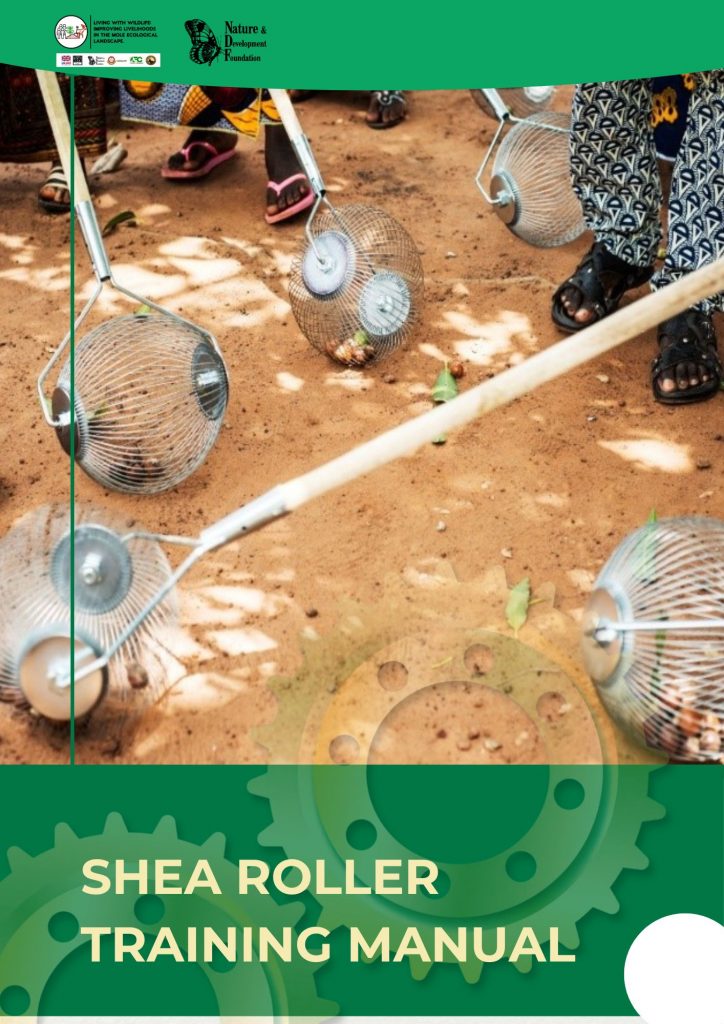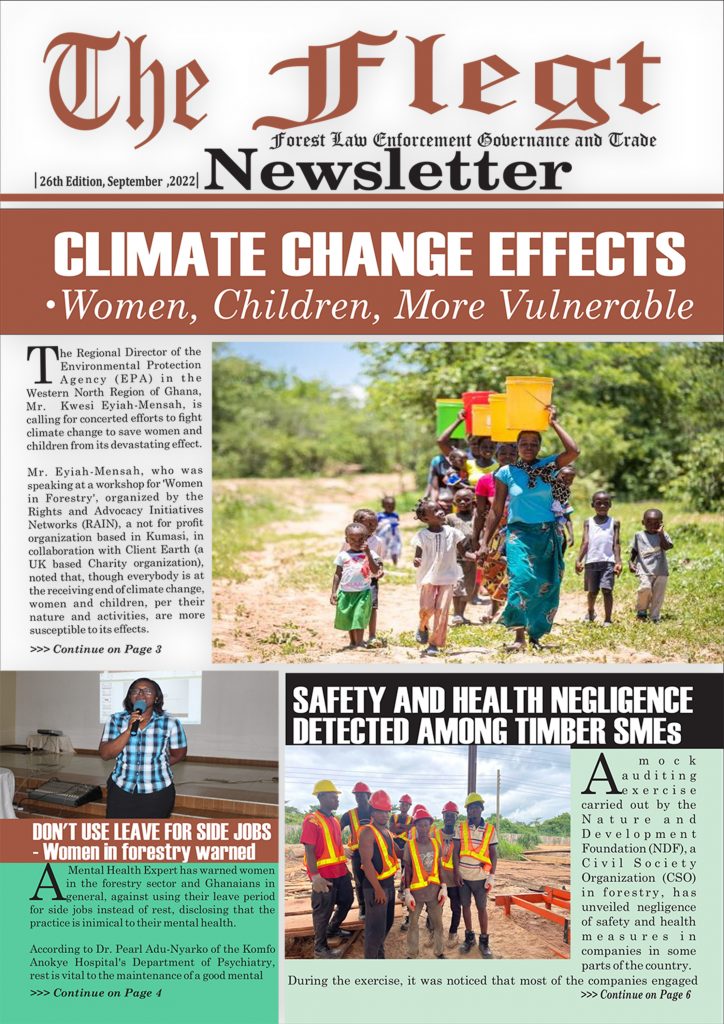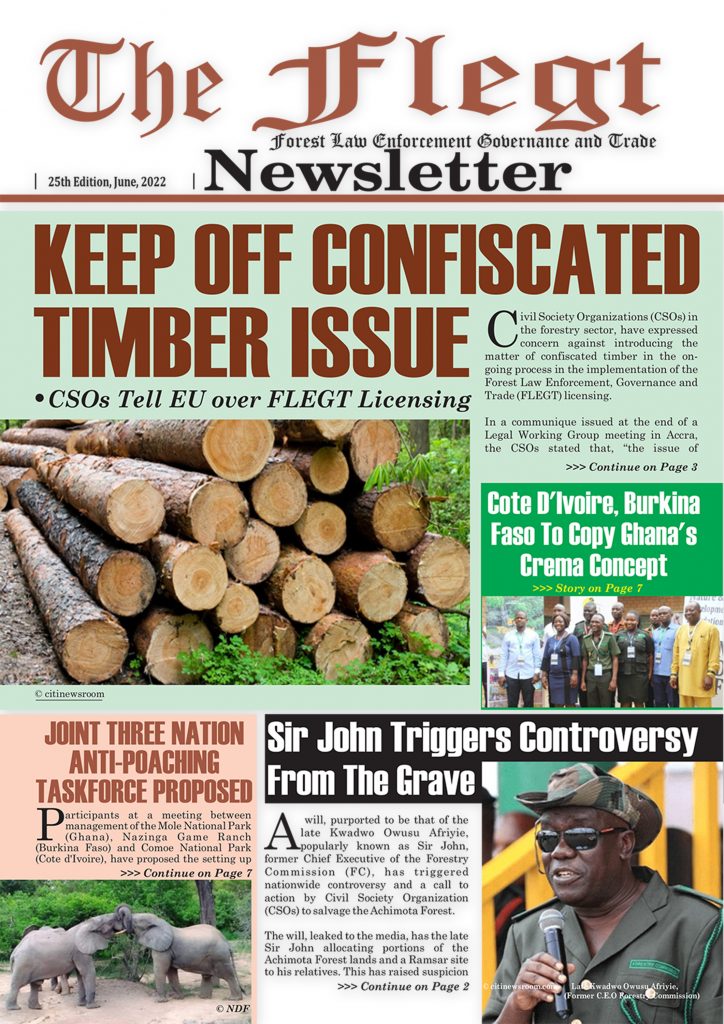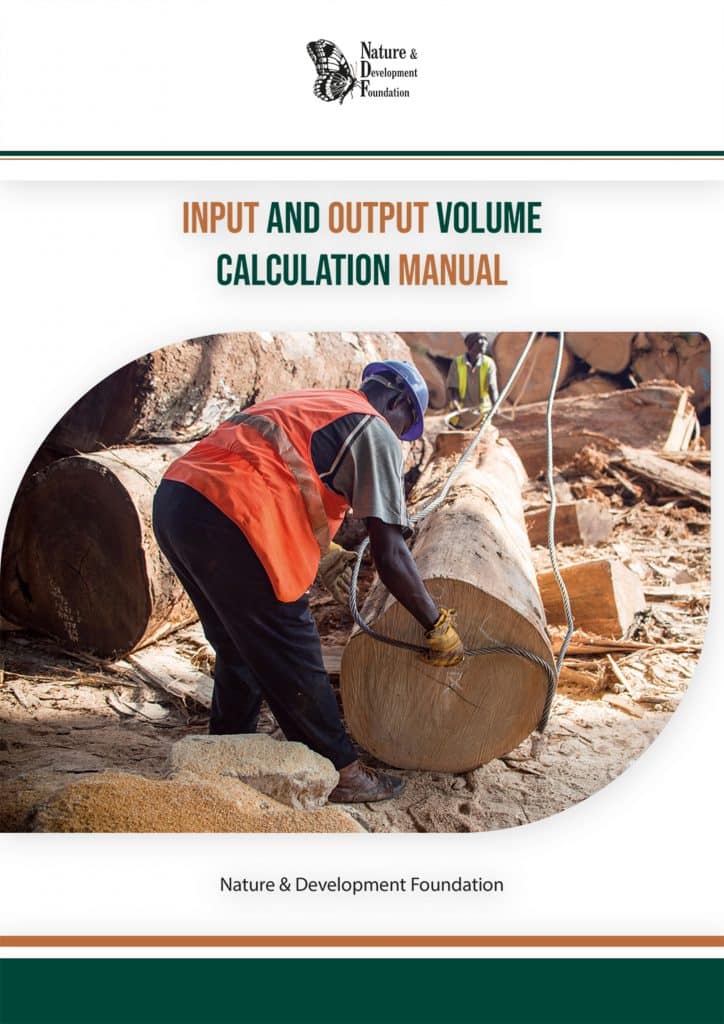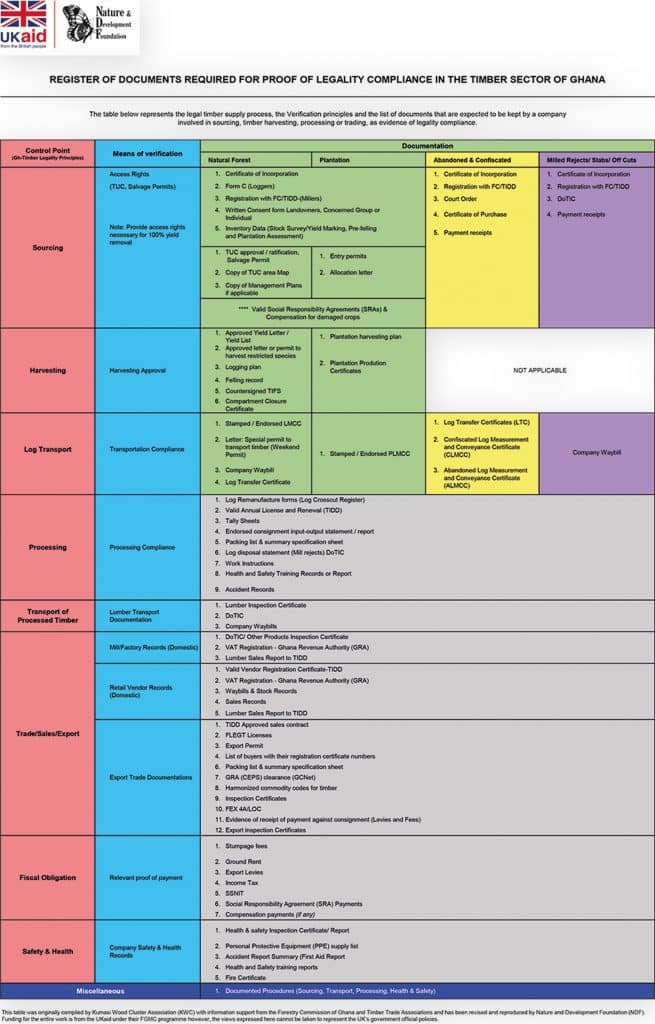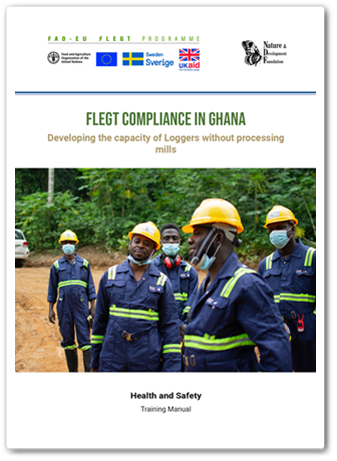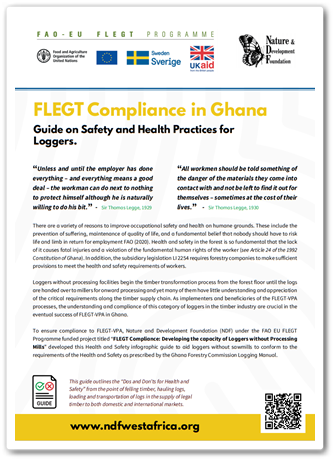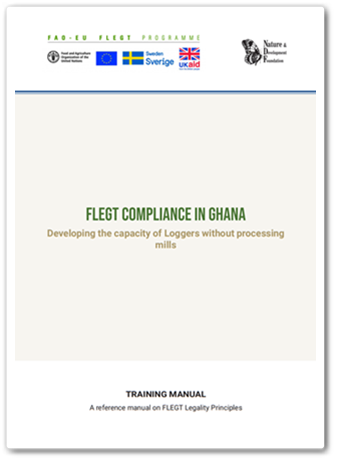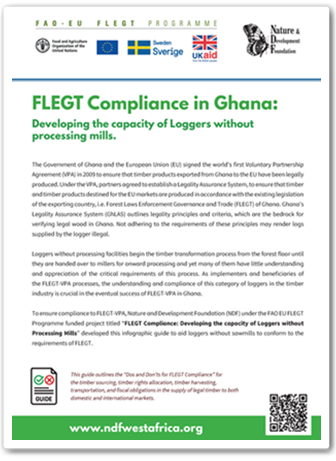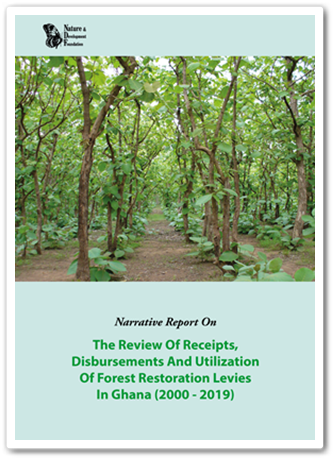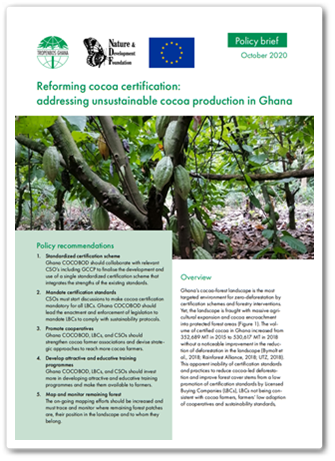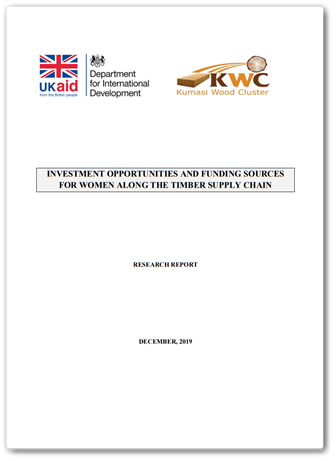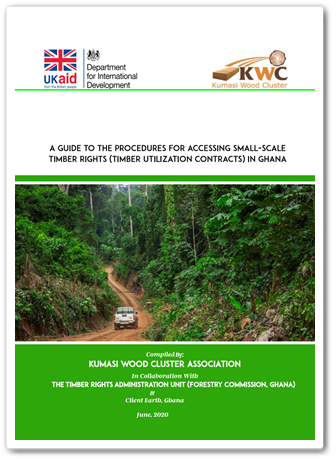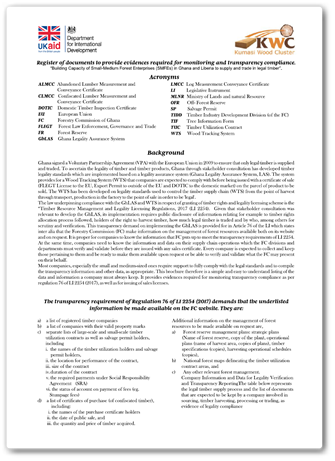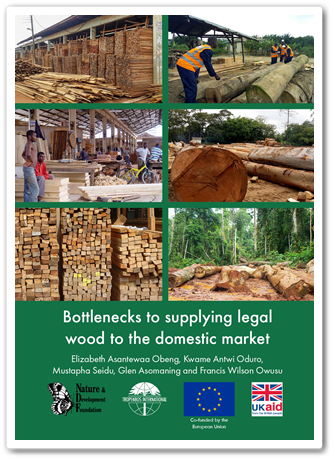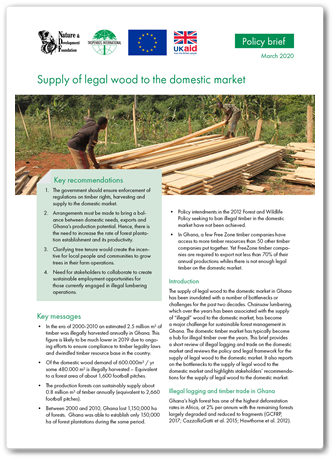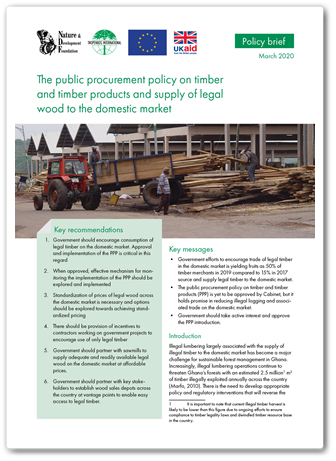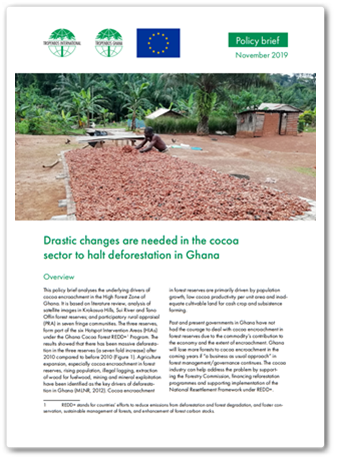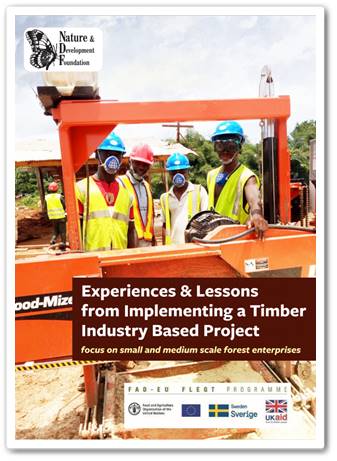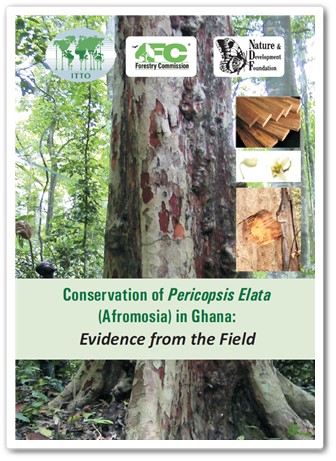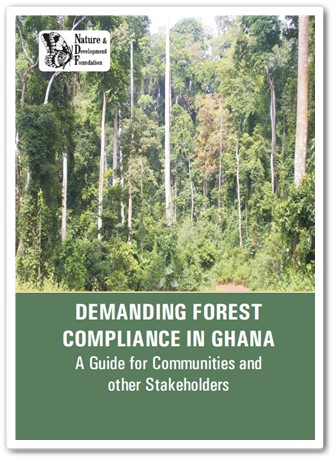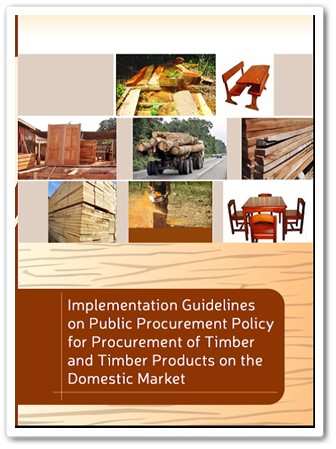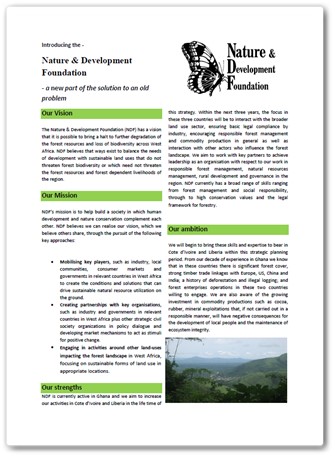Publications
All of NDF's published materials available for free online.
NDF SHEA ROLLER MANUAL
To ensure value for money and avoid duplication of effort, this manual for training on shea nut roller technology is developed for use by all interested persons without restriction. It is concise and user friendly. I therefore recommend this manual for persons who will be leading training on sustainable shea nut collection with the objective to increase quality and quantity of the nuts collected.
The FLEGT Newsletter: 26th Edition
This manual has been developed with the main objective of training and providing concession holders without processing mills and other timber loggers with the appropriate knowledge on health and safety in order to understand their role(s) in the application of health and safety requirements, how to identify hazards or potential hazards that need to be prevented or controlled.
This guide outlines the “Dos and Don’ts for Health and Safety” from the point of felling timber, hauling logs, loading and transportation of logs in the supply of legal timber to both domestic and international markets.
Input and Output Volume Calculation Manual
This manual is designed for use by all timber companies processing logs into products. It is tailored to address the needs of the technical audience in the sector and to provide answers to questions and issues related to their role in the supply of legal timber. The main objective of the manual is to build the capacity of processing mills to comply with FLEGT regulations and address non-compliance with Ghana’s legality system. The manual helps millers perform input and output calculations for their wood products.
It is designed for training purposes, not for sequential use, and is practical and results-oriented.
This guide outlines the steps involved in the legal timber supply process, the principles of verification, and the documentation that companies involved in sourcing, harvesting, processing or trading must retain as proof of compliance with legality requirements. The table highlights the key components of the process and the critical pieces of evidence that companies must maintain to demonstrate their commitment to adhering to the regulations and standards. The documentation listed serves as evidence of compliance with the relevant laws and regulations and helps to ensure that all stakeholders can trust the legality of the products involved in the supply chain.
FLEGT Compliance in Ghana: Health and Safety training manual
This manual has been developed with the main objective of training and providing concession holders without processing mills and other timber loggers with the appropriate knowledge on health and safety in order to understand their role(s) in the application of health and safety requirements, how to identify hazards or potential hazards that need to be prevented or controlled.
FLEGT Compliance in Ghana: Guide on Safety and Health practices for loggers
This guide outlines the “Dos and Don’ts for Health and Safety” from the point of felling timber, hauling logs, loading and transportation of logs in the supply of legal timber to both domestic and international markets.
FLEGT Compliance in Ghana: Training Manual
To ensure compliance to the FLEGT-VPA, Nature & Development Foundation under the FAO-EU FLEGT Programme has developed this manual to aid loggers without sawmills to conform to the requirements. This manual is also aimed at helping loggers to improve on their management systems with regards to timber harvesting, transportation, sales, etc.
FLEGT Compliance in Ghana for loggers without processing mills: Dos & Don’ts
This guide outlines the Dos and Don’ts loggers without sawmills must adhere to in order to conform with the requirements of FLEGT. The guide covers timber sourcing, timber rights allocation, timber harvesting, transportation and fiscal obligations in the supply of legal timber to both domestic and international markets.
The review of receipts, disbursements and utilization of forest restoration levies in Ghana (2000-2019)
Transparency and accountability are the hallmark of good forest governance. A lack of these attributes affect the sustainability of forest estates. One instance of forest governance in Ghana that ought to be of interest to timber industry is how taxes and levies specifically meant for forest plantation development are applied. This study reviews and analyses receipts and disbursements for forest plantation establishment under the Forest Plantation Development Fund and the Forestry Commission/Timber Industry Funds in Ghana.
Reforming cocoa certification: addressing unsustainable cocoa production in Ghana
This policy brief make a case that good agricultural practices, required by certification, lead to higher yields and also pace a change that would support reduction of deforestation in the landscape and improve income for farmers, but it requires implementing a comprehensive cocoa-forest management policy that enforces compliance of sustainable cocoa practices.
Investment opportunities and funding sources for women along the timber supply chain
Under the project “Building the capacity of SMFEs in Ghana and Liberia to supply and trade in legal timber”, distortions in gender engagement in the timber sector are being addressed by offering women training in investment opportunities along the timber supply chain. This report was produced by KWC as part of activities under the FGMC programme. The report outlines investment opportunities available to women entrepreneurs along the timber supply chain in Ghana.
A Guide to the procedures for accessing small-scale timber rights (Timber Utilization Contracts) in Ghana
Two categories of millers’ supply timber to Ghana’s domestic market; large scale and small-medium scale suppliers. Access to commercial timber by both categories is through Timber Utilization Contracts (TUCs) granted via a competitive bidding process. This process disadvantages the small and medium suppliers, as they lack the financial and logistical capacity to compete with large scale suppliers. To address this unfair situation, a legal provision of small-scale TUCs was lobbied in 2017 to ensure a balanced, sustainable and easy access to raw materials for small and medium scale timber suppliers. Even though the procedures for accessing Small-Scale Timber Rights are included in the law, its content appears too technical for many small-scale millers to readily understand and apply hence, the need to write the procedures in a simplified and reader-friendly manner for use by potential small-scale millers. This document was produced by Kumasi Wood Cluster Association (KWC) as part of a set of activities under the Forest Governance Markets and Climate (FGMC) programme.
Register of documents to provide evidences required for monitoring and transparency compliance
Regulation 76 of the Ghana Timber Resource Management and Legality Licensing Regulation 2017, (LI 2254) mandates timber companies to keep a register of documents as evidence required for monitoring and transparency compliance. In order for Small and Medium-sized Forest Enterprises (SMFEs) to compile the information and other data required by the Regulation, they need to be supported with concise information on the needed documents, in a reader-friendly form. The SMFEs need to know the information and data on operations along the timber supply chain that the FC divisions and departments must verify and validate before they are issued with any sales certificates. Thus, a list has been compiled to assist the companies collect relevant data, keep the required documents specific to their operations and be ready to make them available upon request. This document was produced by Kumasi Wood Cluster Association (KWC) as part of a set of activities under the Forest Governance Markets and Climate (FGMC) programme.
Bottlenecks to supplying legal wood to the domestic market
Supply of legal wood to the domestic market
The public procurement policy on timber and timber products
Illegal lumbering largely associated with the supply of illegal timber to the domestic market has become a major challenge for sustainable forest management in Ghana. Increasingly, illegal lumbering operations continue to threaten Ghana’s forests with an estimated 2.5 million of timber illegally exploited annually across the country (Marfo, 2010).
Drastic changes are needed in the cocoa sector to halt deforestation in Ghana
This policy brief analyses the underlying drivers of cocoa encroachment in the High Forest Zone of Ghana. It is based on literature review, analysis of satellite images in Krokosua Hills, Sui River and Tano Offin forest reserves; and participatory rural appraisal (PRA) in seven fringe communities. The three reserves, form part of the six Hotspot Intervention Areas (HIAs) under the Ghana Cocoa Forest REDD+1 Program.
Experiences & Lessons from Implementing a timber industry based project
Illegal logging is estimated to cost between 30 to 100 billion USD globally according to the United Nations Environment Programme and Interpol. In Ghana, the total economic cost of natural resource degradation and poor environmental management including poor sanitation has been estimated at, at least 10% of Gross Domestic Products (GDP).
Conservation of Pericopsis Elata (Afromosia) in Ghana: Evidence from the Field
Demanding forest compliance in Ghana: A Guide for Communities and other Stakeholders
Ghana’s forestry sector is fraught with several challenges. Illegal logging and disregard for the forest laws are considered as major threats to the forest resources of Ghana. Ghana has signed a Voluntary Partnership Agreement with the European Union which provides an opportunity to systematize understanding and respect for the laws applicable to the forest sector.
Implementation guidelines on public procurement policy for procurement of timber and timber products on the domestic market
The purpose of these guidelines is to establish uniform procedures pertaining to the procurement of timber and timber products, based on the Procurement Policy on Timber and Timber Products for the domestic market.
Selected Forum & Workshop Reports Under the Project
Stakeholders in Ghana’s forestry sector had the impression that Ghana would have issued FLEGT licences by now considering how fast the negotiation itself progressed. This has however not happened. Nevertheless, there are some indications that FLEGT licenses would be issued sooner than later with an assurance from the Forestry Commission of Ghana.
Nature & Development Foundation - A new part of the solution to an old problem
The Nature & Development Foundation (NDF) has a vision that it is possible to bring a halt to further degradation of the forest resources and loss of biodiversity across West Africa. NDF believes that ways exist to balance the needs of development with sustainable land uses that do not threaten forest biodiversity or which need not threaten the forest resources and forest dependent livelihoods of the region.
